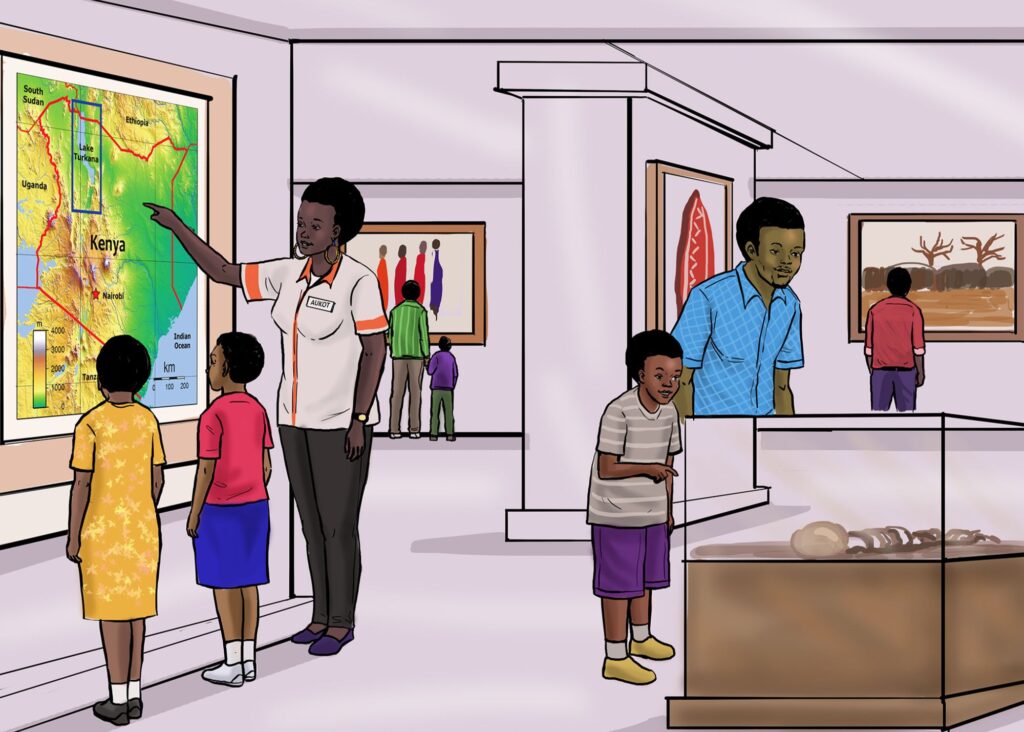The Fossils of Turkana

My friend Anita and I were visiting the Turkana Museum, we were also visiting my cousin Aukot, she works here as a historian. We saw her at the far end and approached her.
“Hi Aukot,” we greeted her in unison.
“Hi guys, welcome to the Turkana Museum. Are you enjoying yourselves?” she asked.
“Yes!” we replied. “We have a question,” I continued, “we overheard a group of tourists talking about The Jade Sea, but we cannot find it anywhere in this map,” I said standing in front of Kenya’s map.
“Here it is, on the northernmost tip of Kenya. The Jade Sea is another name for Lake Turkana,” Aukot explained pointing on the glass case protecting the map.

“Why is it called the Jade Sea?” I asked.
“Because its water is the shade of blue-green; the name of that coluor is jade,” she replied.
Lake Turkana is the world’s largest desert lake.
It is also an alkaline lake, meaning that the water has dissolved salts.
Its waters are neither salty nor fresh water.
“Hey Aukot, is it true that Lake Turkana has the largest population of crocodiles?” Anita asked.
“Yes, that’s true and many residents hunt them for food,” Aukot said.
“Ok that sounds scary!” I added.
We moved on to the next exhibition titled “The Nariokotome boy”.
The accompanying write-up explained that in 1984 a hunter called Kamoy Kimeu found the fossil of a Turkana boy that they called the Nariokotome boy.
This fossil stood out because it was the most intact and complete human fossil ever found.
The boy is thought to have lived between 1.5 and 1.6 million years ago and was one of the world’s most significant archaeological findings.
“This must be why Kenya is referred to as the cradle of mankind.”
“Fascinating!” Anita said, to which I agreed.
“The next exhibition is even more fascinating, if you can believe it,” Aukot said as we moved to it.
The large glass case had stones called the Namoratunga stones.
“The earliest study site in the world about the sky is known as Namoratunga stones. This site serves as evidence that the people of Turkana had a 354-day calendar,” Aukot said walking us to a large glass encasing of stones in a formation, a replica of the original.
“They also used the 7-star system which helped come up with the 354-day calendar. However, to the people in Turkana, Namoratunga is believed to be where the devil turned men into stones. It is also an important date in their traditional calendar,” She added pointing to a paper on the side of the case.
I did not know there was so much about the history of mankind in Turkana.

“Let’s look at a few more exhibits before we take a lunch break,” Aukot suggested.
“This one is the Statue of Christ the Redeemer on a hill in Lodwar,” Aukot said with pride.
“I thought there was only one Christ the Redeemer in the world, on Sugarloaf Mountain in Brazil?” I responded, referring to the familiar painting.
“That was the original one. The one in Lodwar is a replica put up by the Catholic Diocese of Lodwar to mark the stations of the cross.” Aukot explained.
Aukot continued to explain that across Lodwar there are many Christian themed statues to mark these stations and the exhibition room had the familiar photos on the wall.

The next exhibition was on our country’s journey to freedom from the British colonialists.
“Here we have the Lodwar Prison where the Kapenguria Six – who were Kenyan freedom fighters – were held.” Aukot said standing in front of a famous photo of the Kapenguria Six.
“But weren’t the Kapenguria Six detained in Kapenguria which is in West Pokot?” I asked.
“Yes, they were, but the jailers moved them to Turkana which was too far for their friends to travel to and break them out,” Aukot responded.
“Well, that’s Turkana County! How about we go eat?” Aukot suggested as we wrap up our museum tour.



